Posts Tagged ‘fracking’
Follow-Up: Silica Air Pollution at Fracking Sites Out of Control
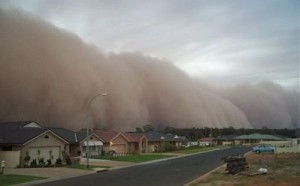 Last summer we told you about a nationwide Centers For Disease Control/National Institute for Occupational Safety and Health (NIOSH) warning to gas and oil field workers about rampant silica air pollution at fracking sites throughout the country. Research had found that pollution standards were being trampled at every site they tested. These were all tests done within the fence line of the well site, so nobody knows what the off-site impacts were/are, or how far downwind they can extend.
Last summer we told you about a nationwide Centers For Disease Control/National Institute for Occupational Safety and Health (NIOSH) warning to gas and oil field workers about rampant silica air pollution at fracking sites throughout the country. Research had found that pollution standards were being trampled at every site they tested. These were all tests done within the fence line of the well site, so nobody knows what the off-site impacts were/are, or how far downwind they can extend.
Now comes a recent follow-up report that breaks down all the information that was the basis of that 2012 industry warning, and its gruesome. Because it's so detailed, we're pasting it in blocks below in one narrative feed.
Fracking uses a lot of sand. There's an entire silica pollution cycle within fracking that's only now getting the attention it deserves. The mining of sand for fracking can take place miles away from the gas or oil plays and threaten new areas never touched by a well. It takes lots and lots of water. There are lots and lots of trucks, and lots of silica in the air at the mine. Just ask the folks along the Red River, to the northwest of DFW in what used to be pristine rolling timbered hill country.
Once it gets to the fracking site, it creates the clouds of silica air pollution that OSHA is so concerned about. The level of exposure the feds found at some of the fracking sites they studied was "enough to overwhelm the maximum use concentration ratings for the half-mask, air-purifying respirators that workers typically wore" while working at the site. Breathing silica is like breathing sand or cement into your lungs. Eventually it fills them up and hardens your air passageways and you suffocate to death. Happens in the cement industry a lot. We know this is a real and current hazard to workers at the site. We have no idea what kind of hazard it is to people off-site. None. Zero. Nada.
This is why regulators must be cautious in deciding things like "setback distances." The difference between 1000 and 1500 feet could be a dramatic drop-off in silica pollution. That could be an important margin of error for public health we need but don't know much about right now.
Here's the story from Robert Iafolla in Bloomberg:
Workers' Silica Exposure at Fracking Sites Far Exceeds OSHA Limit, NIOSH Study Finds
The concentration of silica in the air workers breathe exceeded occupational health criteria at all 11 hydraulic fracturing sites tested by the National Institute for Occupational Safety and Health, the American Industrial Hygiene Association announced July 31.
Researchers measured the silica levels of more than 100 personal breathing zone samples at fracking sites in five states, finding levels above the Occupational Safety and Health Administration's permissible exposure limit (PEL), NIOSH's recommended exposure limit (REL), and the American Conference of Governmental Industrial Hygienists threshold limit value (TLV).
In some instances, the samples exceeded OSHA's PEL by a factor of 10 or more. That level of exposure is enough to overwhelm the maximum use concentration ratings for the half-mask, air-purifying respirators that workers typically wore, the study said.
“Although effective engineering controls for crystalline silica are well established in other industries, controls to limit silica-containing dust generation during hydraulic fracturing are only now emerging due to the relatively recent understanding of the hazard and magnitude of exposure risks,” the study authors wrote.
The study appears in the Journal of Occupational and Environmental Hygiene, published jointly by AIHA and ACGIH.
NIOSH first flagged the occupational hazard of silica exposure at fracking sites in a June 2012 Hazard Alert. The journal article describes the research that informed that alert (42 OSHR 576, 6/28/12).
Silica sand is a crucial and common component in many fracking operations. Silica is often mixed with the water and chemicals injected into shale formations during fracking, with silica acting as a “proppant” to keep the underground fractures open to allow oil or natural gas to flow. Approximately 28 million metric tons of silica sand was used in fracking during 2012, according to the U.S. Geological Survey.
The heavy use of silica is reflected in the air contamination at fracking sites. Just over half of the 111 samples that NIOSH tested exceeded the PEL for silica, while 69 percent exceeded the REL, and 84 percent exceeded the TVL.
OSHA's PEL is calculated from the percent of crystalline silica in the respirable dust; the PEL for 100 percent silica would be 0.1 milligram per cubic meter of air. NIOSH's REL is 0.05 milligram per cubic meter, and the ACGIH's TVL is 0.025 milligram per cubic meter.
OSHA's proposed regulations for silica could lower the PEL to 0.05 milligram per cubic meter, although that has been met with fierce resistance from industry. The proposal has been on hold at the White House Office of Management and Budget since February 2011.
Researchers took samples at fracking sites at five shale formations: Bakken in North Dakota, DJ Basin in Colorado, Eagle Ford in Texas, Fayetteville in Arkansas, and Marcellus in Pennsylvania. The fracking operations at those locations used silica as the proppant, with the exception of the Bakken site, where 60 percent of the proppant was a ceramic material.
None of the 10 samples taken at Bakken exceeded OSHA's PEL. Two-thirds of the samples at Marcellus, 54 percent at Fayetteville, 53 percent at DJ Basin, and 50 percent at Eagle Ford went over the PEL.
Typical fracked gas or oil wells go through 12 to 20 stages, with each stage requiring hundreds of thousands of pounds of sand, creating airborne dust at the sites, the study said.
Sand is delivered from tractor trailers and pumped with compressed air through fill ports into on-site storage and delivery vehicles known as “sand movers.” Those sand movers use motor-driven belts called “dragon tails” to supply sand to blender trucks, with larger loads requiring multiple vehicles moving sand across a transfer belt. Blender hoppers pump the sand-as-proppant through a manifold, piping, and into the well.
Workers operating sand movers and transfer belts are exposed to the highest levels of silica, the study said.
Overall, the study found seven points of dust generation that were common at all 11 sites:
• from “thief hatches” on the tops of sand movers during filling,
• from the sand mover belt,
• from the momentum of falling sand below the dragon tail at the blender hopper,
• from transfer belts when sand is deposited onto the belt and conveyed to the blender,
• from sand leaving the end of the dragon tail,
• from fill ports of sand movers during refilling operations, and
• from truck traffic at the fracking site.
The study said that about 435,000 workers were employed in the U.S. oil and gas extraction industry during 2010, with nearly half employed by well servicing companies, including companies that use fracking.
The study “Occupational Exposures to Respirable Crystalline Silica During Hydraulic Fracturing” is available at http://tinyurl.com/mn5sbc3.
Past Colorado Medial Society Prez: Fracking is an “Experiment in Motion” on Public Health
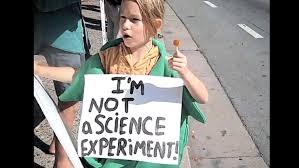 Dr. Michael Pramenko seems like a reasonable guy. He's not a Greenpeace treesitter, or running for elected office, or part of any unruly mob.
Dr. Michael Pramenko seems like a reasonable guy. He's not a Greenpeace treesitter, or running for elected office, or part of any unruly mob.
In fact, he's so reasonable that he's the former president of the Colorado Medical Society.
And Dr. Pramenko calls the current hydraulic fracturing boom in the state’s oil and gas industry an “experiment in motion. One that could lead to higher rates of cancer and other illnesses over the next 10 to 15 years."
But he's not concerned with the massive acute exposures that can happen during accidents or blow-outs. No, he's concerned with the harm done by the routine, boring everyday kind of low-level chronic exposure that the Texas Tech researchers in the post below are documenting.
“Are there people out there being exposed to low quantities [of carcinogens] that we won’t ever know about? Sure,” he said. “Are there going to be some cancers down the road that come about across the United States? I think that's true.
You'll be relieved to know that state regulators have everything under control. Colorado Department of Public Health and Environment (CDPHE) spokesman Mark Salley said the department closely monitors the industry to protect public health: “The [CDPHE] has regulations in place, including required permitting, set-back requirements, use of ‘best practice’ methods by industry to minimize the impacts.”
Yes, that should do it.
There are 50,771 active oil and gas wells in Colorado – 20,260 of them in Weld County on the northern Front Range. More than 90 percent of the state’s wells are fracked at least once and often multiple times.
Trying to regulate fracking hazards is like trying to hit a moving target. Every month there's a new study out that shows a new threat or one that has been under-emphasized. Like so many other on-going experiments we're a part of, this one will claim thousands before we understand what was really happening.
City Hall Apparatchiks Rewrite History, Now Say 1500-Foot Setback Vote Never Happened
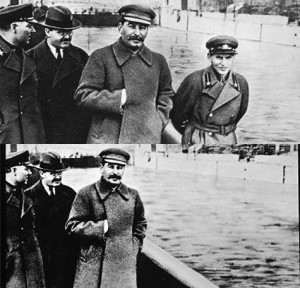 Any doubt that Dallas City Hall is more interested in protecting the Trinity East gas leases than Dallas residents as it writes a new gas drilling ordinance was surely removed yesterday when City Attorney Tammy Palomino flatly lied and told City Plan Commission members that they had not decided on a 1500-foot setback, or buffer zone, between homes and other "protected uses," even though they had done precisely that at their June 20th meeting.
Any doubt that Dallas City Hall is more interested in protecting the Trinity East gas leases than Dallas residents as it writes a new gas drilling ordinance was surely removed yesterday when City Attorney Tammy Palomino flatly lied and told City Plan Commission members that they had not decided on a 1500-foot setback, or buffer zone, between homes and other "protected uses," even though they had done precisely that at their June 20th meeting.
Employing the Orwellian language of a Soviet history writer, Palomino simply choose to ignore the results of a decision she didn't like and pretend the vote never happened. She argued that there was "no consensus" on the CPC for a 1500-foot setback – even though that very word was used to describe the results of June 20th meeting by CPC members themselves, as well as the media.
Instead, she handed out an official "summary" of CPC drilling recommendations to-date that not only only didn't include ANY mention of the 1500-foot setback decision, but instead listed a 1000-foot setback limit that had specifically been rejected by the Commission!
That missing footage is critical. 1000-foot setbacks, with a variance (or exception) up to 500-feet, were recommended by the city's gas drilling task force, but we now know those recommendations were tailored to fit the circumstances of the Trinity East lease sites along the Trinity River in northwest Dallas. That is, with a variance that could put wells 500 feet from homes, the Trinity East sites could be approved. With the CPC's 1500 foot-setback, there's only a variance to 1000 feet. That makes it impossible for Trinity East to set up shop where they want. And that's why Palomino deliberately, but unethically, left the 1500 setback out of her "summary."
The problem for Palomino in trying to pull this kind of disappearing act is that there were way too many witnesses to the original vote, including reporters. According to KERA's account "One of the first changes that grabbed consensus of the Plan Commission was an increase to the buffer zone or setback between gas wells and homes, businesses, schools, and recreational areas. Plan Commissioners want 1500 feet, not the 1,000 recommended by the task force." Channel 4 reported the same thing. There's also the fact that the city archives audio tapes of every CPC meeting, and citizens have have begun to videotape the meetings to catch this kind of bullying by staff.
What all of this will show is that on June 20th CPC member Paul Ridley took great pains to clarify that the CPC had indeed reached a consensus that they wanted a 1500 foot setback – considered the most protective setback currently used by any North Texas city. He even asked the question, "Do we have consensus on this?" and heads all nodded and not one verbal objection can be heard – other than from Tammy Palomino – who is stuttering that the city attorneys are going to have to make sure they can do this (no explanation of why Dallas can't). There's no question about what happened.
Which is why even the most cynical observers were shocked at the clumsy effort by Palomino to erase the decision from history by way of her "summary." It's like the City can't pass up an opportunity to create an ethical crisis whenever it deals with the Trinity East leases.
All the video and audio tape is being assembled into a nice neat package for the public and media. The case against Tammy Palomino will be devastating. As a result of her premeditated misrepresentations, Palomino should resign, or at the very least be re-assigned away from work on the new gas ordinance. She's representing Trinity East in these proceedings, not the citizens of Dallas.
Yesterday's episode was but the most extreme example of the kind of bullying and steamrolling that staff is employing against the CPC to end up with an ordinance that is Trinity East-friendly. As they have for the past three years or so, they're contorting the system to make it fit Trinity East's permits.
Besides the setbacks issue, staff really wants the CPC to OK gas drilling in parks, and a majority of CPC members today were willing to say out loud they supported that goal. That's right – after 7 months of crowds filling city hall to protest drilling in parks, Official Dallas is still moving toward approval of that idea. It's based on the idea of "unused" park land – a concept that has never been defined by the city or anyone else.
Trying to further this goal, staff actually came to Thursday's meeting with a US Parks Department definition of "active" and "passive" park land with the idea that Dallas could adopt something similar and allow drilling on the "passive" acreage. According to the list, "passive" park land is defined as land used for hiking, rock climbing, horseback riding, mountain biking, and camping, among others activities. Sounds pretty "active" doesn't it? Despite their propensity to allow park drilling it struck the CPC the same way and they firmly rejected staff's approach. Still, just like the 1500 foot setback issue, staff won't be satisfied until they get Trinity East what it wants.
Which brings us to a hard truth that the media and the public need to absorb. As bad and blatant as it is, Tammy Palomino's unethical behavior is only a symptom of a much larger rotten problem with this entire gas drilling ordinance process that has been present from before the task force was created right up until now. It's impossible for staff to both be advocates for the Trinity East leases in the writing of a new gas ordinance and give objective counsel to the CPC and Council on how to write the most protective ordinance. They cannot serve two masters.
Palomino and others have been told they need to find a way to make sure Trinity East gets what it wants in this new gas drilling ordinance. That makes city staff just another lobbying arm of Trinity East, not honest brokers trying to produce the best and most protective policy for Dallas residents. Every piece of advice they give is meant to further the leases, not the public good.
Because of this fact, an independent counsel needs to be brought in for the purpose of helping draft this new gas drilling ordinance. Policymakers need to have the best information, the most objective information, if they're going to make good policy. They're not getting it from city staff when it comes to drilling.
It's time to quit pretending this isn't a big problem. When city attorneys start trying to erase public policy decisions because they conflict with a private interest they're serving, the system is no longer working. It's corrupt and must be replaced before that corruption is allowed to spread.
Stay tuned. You're going to be hearing a lot more about this.
Scheduling Note: Although the CPC released a schedule for its work on the drilling ordinance only last week, including three public hearings, things may be changing quickly with additional workshop times and different dates and times for hearings. There was a lot of talk about schedule changes on Thursday, but nothing was decided. Right now the first opportunity for you to express outrage at this latest development is a public hearing slated for August 15th, 4 to 6 pm, at City Hall but stay tuned to make sure.
It’s Official: Trinity East Zombie Permits Coming Back; Dallas Gas Ordinance Rewrite Schedule Released – 1st Public Hearing August 15th
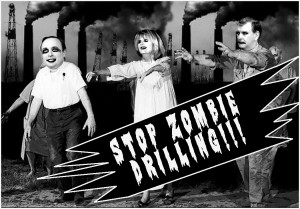 They just won't take a big fat public "No!",
They just won't take a big fat public "No!", or two, or three, for an answer.
We've learned form sources inside City Hall that Trinity East – with a big assist from City of Dallas staff and Mayor Mike Rawlings – is preparing to once again attempt to permit its three proposed drilling and refinery/compressor station sites along the Trinity River.
While the company and city staff keep trying to win support for a weaker new gas drilling ordinance than citizens have repeatedly requested, a deal is being wheeled that would have Trinity East trading its lease on park land for another piece of city-owned property in northeast Dallas. Meanwhile, the City is also working feverishly to firm up support for its official position that it can't possibly turn down Trinity East without losing a lawsuit – an opinion no one outside of City Hall, save Trinity East, shares so far.
Yeah, the secret gas deal that the Observer uncovered in February got City Manger Mary Suhm to finally leave the building come December, but she's not going until she gets those Trinity East sites permitted the way she promised behind closed doors.
All of which makes the writing of a brand new Dallas gas drilling ordinance even more important now. And last week the City Plan Commission released its two-month schedule of how that's going to be done (see below), complete with three (daytime) public hearings with an ETA to the City Council by October.
There will be just six more meetings of the Plan Commission to review the almost two-year old Dallas Gas Drilling Task Force recommendations and decide to take them at face value, strengthen them, or weaken them. Scatted among these will be three public hearings – the first one in a little over two weeks on August 15th from 4 to 6 pm. The Commission goal is to get a new drilling ordinance to the City Council by October, when the terms of current members expire.
That's the official agenda. The unofficial one is trying to find ways to weaken the new ordinance enough to allow Trinity East to be able to get their proposed sites permitted. There's already been plenty of evidence at previous meetings indicating how desperate staff is in trying to give their departing boss a going-away gift.
We know most of you can't come to the Plan Commission workshops on Thursday mornings to follow the nitty-gritty of how this plays out. We'll be there reporting that to you, no problem. But what we can't do is manufacture warm bodies to put in seats for those three public hearings. Please make it a point to show up at one or more of these – and in particular, the very last one on September 26th as it rolls into the City Council.
Trinity East lobbyist Dallas Cothrum is on record as saying the company's three previously proposed sites on parkland, flood plains and near a new soccer complex that have now been rejected twice by this same CPC were the "best possible" places the company could have chosen for drilling and processing. So now the battle is over the less-than-best possible places. We can't wait to see what part of town the City and Trinity will decide to sacrifice for that designation as part of their possible land-swap deal.
Making sure a new drilling ordinance is the most protective it can possibly be is the only way left to finally drive a stake through the heart of the Trinity East gas permits. You have no idea how much we hate to ring the alarm about these damn permits again, but the stakes are very high and we're on the verge of winning one of the Barnett Shale's biggest citizen victories – if we can just keep the pedal to the metal. Bring your lead feet to the first hearing on August 15th.
Schedule for the City Plan Commission's Workshops and Public Hearings on the New Gas Drilling Ordinance
(All workshop meetings start at 9 am and take place on the 5th floor at 5ES in City Hall unless otherwise indicated. Specific Room locations for the Public Hearings at City Hall will be announced. Topic #’s refer to the Dallas Gas Drilling Task Force Recommendations Matrix.)
THURSDAY, JULY 25
9:00 am – 12 Noon CPC Workshop
• Topic 4 – Pad Site Operations
THURSDAY, AUGUST 8
9:00 am -12 Noon CPC Workshop
• Topic 9 – Gas Drilling/Well Permit
• Topic 14 – Bonding Requirements
• Topic 15 – Site Monitoring and Review of Permit Application
THURSDAY, AUGUST 15
1:30 pm – 3:30 pm Workshop
• Topic 13 – Required Plans
THURSDAY, AUGUST 15th PUBLIC HEARING: 4:00 – 6:00 pm
THURSDAY, AUGUST 22
9:00 am to 12 Noon CPC Workshop
• Topic 1 – Air Quality
• Topic 2 – Water
THURSDAY AUGUST 29
9:00 am – 10:45 am CPC Workshop
• Topic 3 – Physical Pad Site
• Topic 16 – Emergency Response
• Topic 5 – Abandonment and Restoration
THURSDAY, AUGUST 29th PUBLIC HEARING: 11:00 AM -12:00 NOON
THURSDAY, SEPTEMBER 12
9:00 – 12 Noon CPC Workshop
• Topic 10 – Seismic Permits
• Topics 6 – Pipelines and Compressors
THURSDAY, SEPTEMBER 26th PUBLIC HEARING 1:30 PM -?
(Agenda: What to recommend to City Council)
Post Election Dallas Drilling Update – 7 For, 6 Against, 2 Wild Cards
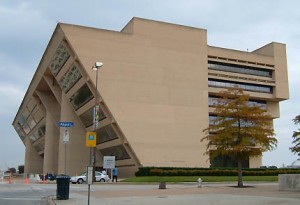 With the election of Philp Kingston and Rick Callihan, the new edition of the Dallas City Council is complete. The good news is that the last six months of hand-to-hand civil combat over the Trinity East gas permits seems to have paid-off in expanding the number of gas drilling opponents to at least six members
With the election of Philp Kingston and Rick Callihan, the new edition of the Dallas City Council is complete. The good news is that the last six months of hand-to-hand civil combat over the Trinity East gas permits seems to have paid-off in expanding the number of gas drilling opponents to at least six members
The bad news is that hard-core supporters still retain seven seats, with two new members hard to read given their campaign answers.
Supports Drilling
Mayor Mike Rawlings
Dwaine Caraway
Vonciel Hill
Terrell Atkins
Sheffe Kadane
Jerry Allen
Rick Callihan (new)
Opposes Drilling
Scott Griggs
Philip Kingston (new)
Sandy Greyson
Carolyn Davis
Monica Alonzo
Adam Medrano (new)
?
Lee Kleinman (new)
Kleinman's DMN questionnaire answer: "I will not take a position at this time because the issue is far to complex to evaluate in the midst of a campaign. The Task force spent 9 months on this issue and I personally know and respect a number of its members. The Council has yet to adopt its recommendations and it will take a much deeper study of the facts before I can take a formal position."
DMN campaign debate coverage: "(He didn't take) firm positions on hydraulic fracturing in Dallas, but said drilling probably shouldn’t occur around residential areas or kids’ soccer fields."
Jennifer Stabach-Gates (new)
Stabach-Gates' Dallas Real Estae News questionnaire answer: "I am opposed to fracking in neighborhoods or near public spaces. There are limited areas in Dallas where fracking would be considered, and these should be addressed on a case by case basis. But as a rule, I will always place a higher priority on protecting neighborhoods and the health of our residents."
Hard to tell when the first vote to test these categories will occur. Officially, the council has yet to take a vote on the Trinity East permits. But rumor has it that the City Plan Commission will be getting briefed by Mary Suhm's legal staff on what a new drilling ordinance should look like this coming Thursday at City Hall, so maybe we won't have to wait that long to see how much the same or different this council is from the last when it comes to the most important environmental fight in Dallas in the last 20 years.
How Mary Suhm Fracked Herself
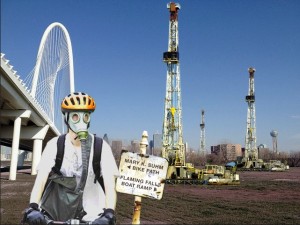 When you take on polluters, you take on the government that lets them pollute. The two are intertwined.
When you take on polluters, you take on the government that lets them pollute. The two are intertwined.
On Thursday, Dallas City Manager Mary Suhm announced that she was resigning. Just about every news account of her announcement connected it to a series of missteps over the last several years, most prominently, the February disclosure by the Dallas Observer that she had signed a previously unknown agreement with Trinity East promising to work with the company to overturn current policy and help secure permits to drill for gas in city parks.
Although superficially dealt with by an official airing in front of the Council where most members forfeited their roles as keepers of the public trust, the issue kept floating to the top of any discussion about not only the Trinity East permits, but the general issue of gas drilling in Dallas. Every City Council race questionnaire this election cycle had queries about not only the specific permits, but also about the performance of the City Manager in wrestling with the scandal. This wasn't going away.
Suhm had what she believed was a plausible public explanation for how she made an honest mistake in misleading the Council over the agreement….for five years. What was always lacking was an explanation for why she continued to lie to Dallas residents about it for that long. Not one word of any defense of her focused on why it was wrong for a city official to align herself against citizens fighting irresponsible drilling and not tell them about that alignment as the entire city went through a multi-year reassessment of urban drilling, first with a moratorium on new permits, then a gas drilling task force, then the permitting process for the Trinity East permits themselves.
instead she directed city staff to distort the system to enable illegal permits to appear legal. Zoning classifications appeared or disappeared depending on the forum. One-off exemptions were carved out as necessary. Park drilling? Perfectly fine under these "special" set of circumstances. Flood plain drilling? No problem either. Anything to make these square pegs fit in otherwise round holes.
Common decency and allegiance to democratic principles demands that she should have publicly disclosed the agreement with Trinity East the minute a review of current city drilling policy began. She did not. When it was involuntarily disclosed for her by the Observer, she looked exactly like the co-conspirator she was.
There's no question that the fight citizens' groups have waged against the Trinity East permits led directly to the disclosure of the agreement. Based solely on circumstantial evidence, it was clear that there was some kind of unpublicized deal that had been "cut" between City Hall and Trinity East. Looking for it became the political equivalent of looking for Dark Matter in the Universe. Everything happening pointed to its existence, but you couldn't actually see the thing itself.
But here's the punch line. Citizens only started to look for that deal after Suhm and the Mayor decided to fast-track the Trinity East permits in late November. It was that decision, made without any warning to the residents that had been involved in the drilling fight, and abruptly ending a year-plus long moratorium on new gas permits, that re-energized opposition and led to Suhm's resignation only six months later. Suhm fracked herself the minute she began to plot with the Mayor to undercut due process and try to pull a fast one on citizens. If they hadn't been in such a clumsy rush to get the Trinity East permits approved, none of this would have happened like it did.
Last week's municipal elections solidified a slightly more independent Dallas City Council, with new and re-elected members who openly oppose the Mayor's pro-drilling stance. Trinity East's permits, which needed a Council super-majority to be approved, look to be doomed. Rawlings' own political future is clouded – how many North Texas mayors have unpopular proposed refineries named after them? The landscape of city politics has changed over the last six months. Citizens fighting City Hall did that. But it was City Hall itself who set it in motion.
Dallas City Council Elections and Drilling: Mayor’s Plan Fails, What’s Next?
 The dust hasn't completely settled, but it's clear that Saturday's municipal election generally strengthened anti-drilling sentiment on the Dallas City Council.
The dust hasn't completely settled, but it's clear that Saturday's municipal election generally strengthened anti-drilling sentiment on the Dallas City Council.
This happened because of two things: 1) Residents elected anti-drilling candidates outright (Griggs and Medrano, with a run-off for Kingston), and 2) a couple of hard core supporters of the Mayor's and Mary Sumh's drilling plans were replaced by candidates who are more conditional in their support for how and where to drill than their predecessors (Kleinman replaces Koop, Griggs replaces Jasso).
Both of those factors can be traced directly back to all the constructive hell-raising citizens have been doing over the past two years or more. Every single candidate questionnaire had a query about gas drilling in Dallas. It came up at debates and forum and interviews. You made it an issue that even business-backed candidates had to address in a citizen-friendly way. You changed to tone, the content of the debate. You did that.
Our citizens' slate won two out of five races outright, with a chance to make it three out of five if Kingston wins the June 15th run-off. Unfortunately, Claudia Meyer lost her race to Vonciel Hill despite a lot of hard work and grassroots effort. And drilling opponent Leland Burk lost to Jennifer Staubach-Gates.
The June 15th run-off is now very important indeed, because it could give us up to 6 votes on the Dallas City Council against irresponsible urban drilling, with a possible 2-3 more swing votes coming over to our side depending on the permit and the site. You need 8 votes out of 15 to win. We're very close.
Besides the Kingston run-off with industry-backed Bobby Abtahi, there's also the District 5 run-off pitting Jesse Diaz against Rick Callahan – both very conditional drilling supporters who appear to be against park drilling.
So here's the Dallas Drilling scorecard as of today:
Opponents of Drilling
Greyson
Griggs
Davis
Alonzo
Medrano
June 15th run-off:
Kingston
Unconditional Supporters of Drilling:
Rawlings
Hill
Atkins
Caraway
Allen
Kadane
June 15th run-off:
Abtahi
Conditional Supporters – based on public statements
Staubach-Gates
Kleinman
June 15th run-off: Diaz or Callahan
Short-term, these election results look like they doom the zombie Trinity East permits. We only need four Council votes or more to uphold the City Plan Commission denial of those permits. We have at least five now, with the chance for 6 or more after June 15th. So the Mayor's plan to hold off on voting on these permits until after the election in hopes of finding more supporters has failed.
This is no small accomplishment. Last November, when the Mayor held a press conference and announced that he was breaking the informal moratorium that was holding back all permit requests until a new ordinance was written and pushing the Trinity East permits through for approval, it indeed looked like a "done deal." And as recently as April, some Dallas City Council members were telling their peers in Irving not to fret, because, despite the Plan Commission vote, the Trinity East permits were still a "done deal."
Well, folks that deal is done now. Well done. As in, put a fork in it. Congratulations. The Mayor tried to pull a fast one and he didn't succeed because of the fierce resistance he got from his own residents. We should know soon when the Trinity East vote will be, and when it's scheduled, we'll need you at City Hall once again to show the new city council that fierce resistance in person. Maybe that will make an impact on their future voting.
Longer term, the new Council will have more members who are opposed to all drilling in Dallas, not just in parks and flood plains, but they don't yet constitute a majority. They're at direct odds with the six Council incumbents who are avid supporters of drilling everywhere and anywhere. Somewhere in the middle – at least until the first vote or so – will be the three freshman members who are possible swing votes.
Their views will be increasingly important if one or both things begin to happen – there is movement to actually write a new gas drilling ordinance after the Trinity East permit denials are upheld, and/or Luminant follows through on its plans to drill and build a compressor station at North Lake and submits permit applications that will be at the center of yet another round of public controversy.
For now, let's concentrate on the June 15th run-off and getting a 6th anti-drilling vote on the Dallas City Council. Its not 8 yet, but it's pretty darn close and construction is still in progress.
Irving City Council Passes Resolutions Opposing Dallas Drilling; Dallas Council Member Reverses Position
 Opening up another official front of opposition, the Irving City Council unanimously passed two resolutions at their regular monthly meeting Thursday night that puts the city on the record against Dallas' plans for park and floodplain drilling.
Opening up another official front of opposition, the Irving City Council unanimously passed two resolutions at their regular monthly meeting Thursday night that puts the city on the record against Dallas' plans for park and floodplain drilling.
Besides rhetorically taking a side, Irving opposition could be important because Trinity East Big Cheese Tom Blanton told the city's officials last month that, although the controversial wells and refinery the company wants to build on the banks of the Trinity will be within the City of Dallas, the lateral drilling from those wells are actually planned to go under the City of Irving. They'll put the straw down in Dallas but Trinity East wants to really drink Irving's milkshake
One resolution was aimed at opposing the three Trinity East permits themselves and a second one was aimed at opposing drilling in, on or near Irving city parks. Since both were on the Council's "consent agenda," there was no discussion so we don't know if there's a second shoe that's going to drop in terms of denying mineral rights to Trinity East outright. That might be complicated by the fact that there are already at least two wells near the University of Dallas (in Irving) that the company drilled on behalf of itself and others, including the City of Irving.
Irving's opposition comes a week after the revelation that Dallas City Council member Monica Alonzo, in whose district all three Trinity East wells are located, now "opposes drilling anywhere in the city," a U-Turn on the subject, since just last year she was reported as salivating at the prospect of royalty money from the wells. That could also be critical, because council members often defer to their colleagues when it comes to zoning matters within each other's districts. Of course, there's one way to prove her new-found conversion – sign-on to the internal memo that Council members Scott Griggs and Angela Hunt have circulated asking for five signatures to bring the matter up for an immediate vote by the full council.
Dallas Morning News Says Enough is Enough: Deny Gas Permits
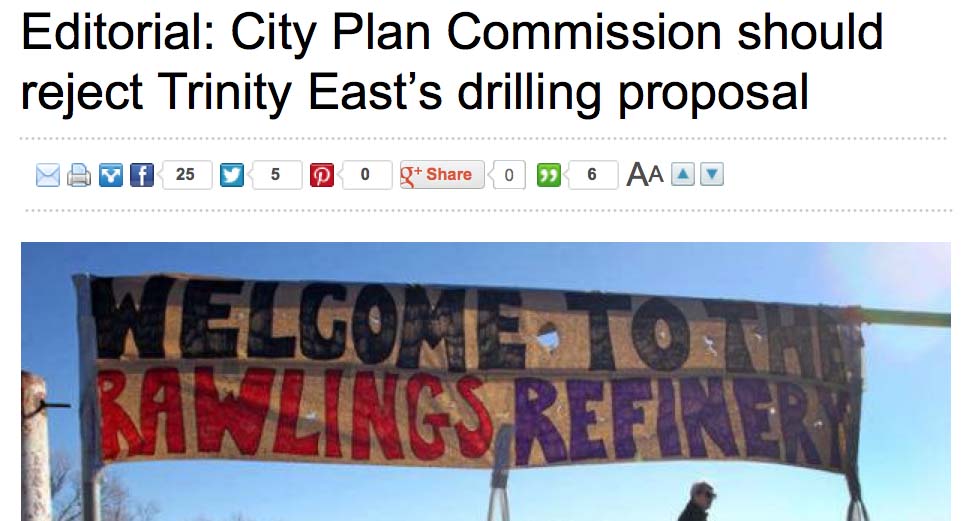 Win, lose or draw at Thursday's City Plan Commission vote, there is no question that, slowly, but surely, residents have built a consensus of public opposition to the Trinity East permits. For the latest proof, look no further than Wednesday's lead editorial in the Dallas Morning News advocating denial. It's the first time the paper has taken such a position. We know some of you can't get over the DMN paywall, so as a public service, here's the whole peice.
Win, lose or draw at Thursday's City Plan Commission vote, there is no question that, slowly, but surely, residents have built a consensus of public opposition to the Trinity East permits. For the latest proof, look no further than Wednesday's lead editorial in the Dallas Morning News advocating denial. It's the first time the paper has taken such a position. We know some of you can't get over the DMN paywall, so as a public service, here's the whole peice.
Dallas Fracking Mystery Tour
